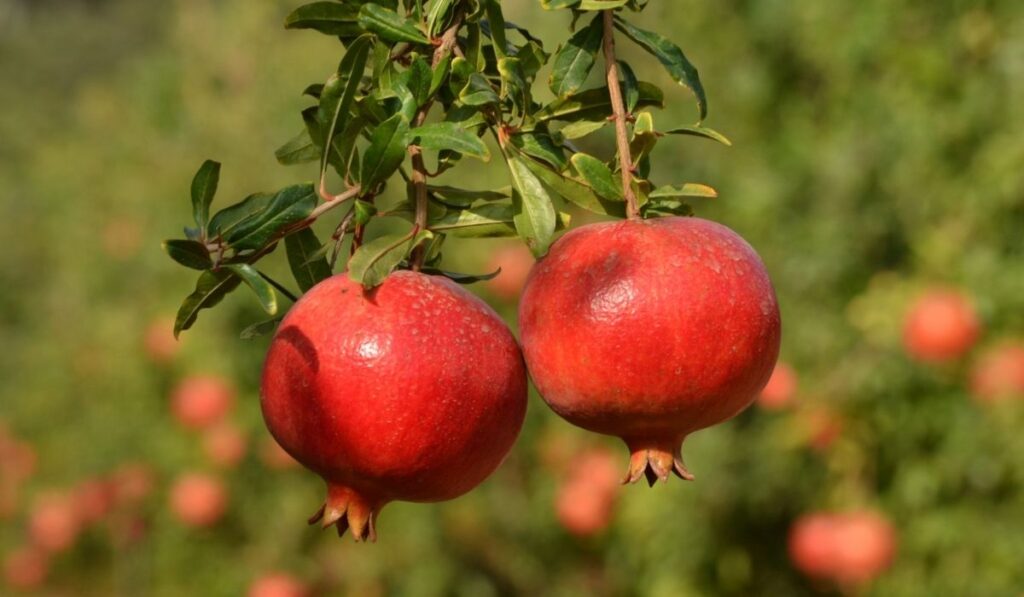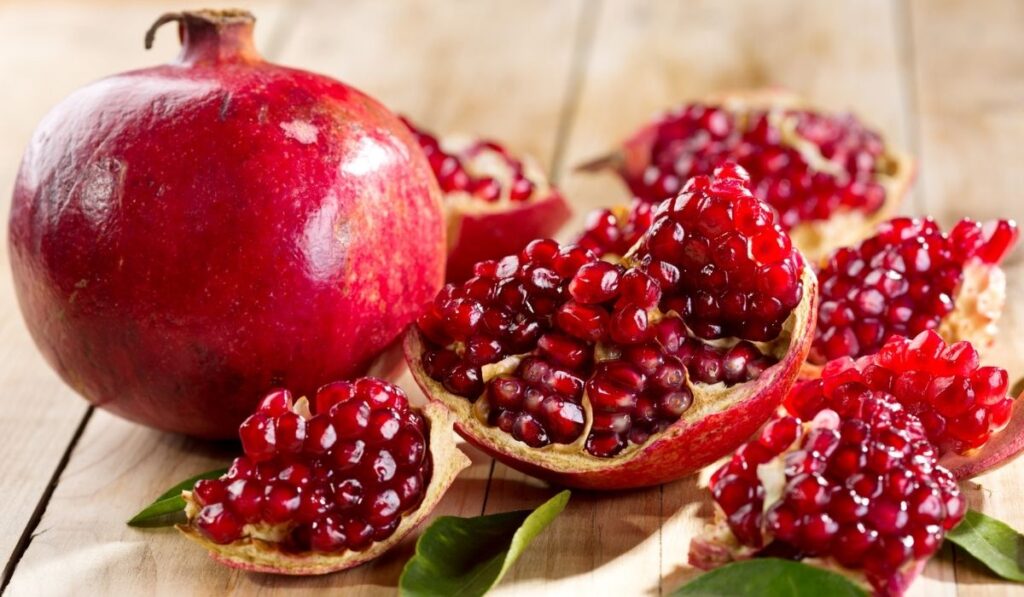The pomegranate is a round or oval fruit with a hard outer shell and leathery skin. Inside the fruit are hundreds of tiny seeds embedded in a juicy, red pulp. The seeds are surrounded by thin membranes that can be eaten along with the seeds. Pomegranates can be eaten fresh, juiced, or made into jam.
Pomegranates come in various colors, depending on their stage of maturity. Ripe pomegranates are deep red, while unripe ones are more pink or white. A ripe pomegranate also sounds hollow when tapped on the outside and has a dry and brown stem. An unripe pomegranate has a green stem.
If you’re craving a juicy pomegranate, you’re in the right place. Let’s look at when, why, and how to tell if a pomegranate is ripe and ready to eat, as well as how to store pomegranates and the health benefits they offer.
What Time of Year Can You Buy Pomegranate?

California produces about 98% of the United States pomegranate crop, and they’re usually in season there from late September through early December. In the Southern Hemisphere, they’re in season from March to May.
When in season, pomegranates are widely available in supermarkets. Out of season, they can often be found in the freezer section.
Another popular way to enjoy pomegranate year-round is as a refreshing juice like POM Wonderful (on Amazon).
How Can You Tell If a Pomegranate Is Good?
To tell if a pomegranate is ripe and ready to enjoy, you’ll want to look for a plump fruit that feels heavy for its size. The skin should be intact and free of blemishes. When you give the fruit a gentle squeeze, it should yield slightly to the pressure.
Avoid pomegranates that are soft or have broken skin. When you cut into a ripe pomegranate, the seeds (or arils) should be juicy and red. If the seeds are dry or brown, the fruit is past its prime.
Pomegranates are prone to mold, so be sure to check for any signs of mold before purchasing or consuming the fruit.
Are Pomegranate Seeds Good for You?
Pomegranate seeds are an excellent source of antioxidants, which can help protect your cells from damage. They’re also a good source of fiber and vitamins C and K.
To get the most benefit from pomegranate seeds, buy them fresh. You can tell if they’re fresh if they’re plump and red. Avoid pomegranate seeds that are dry or brown.
When you eat pomegranate seeds, be sure to chew them well so that you don’t swallow any whole seeds that can damage your digestive tract.
You can also find dried pomegranate seeds (on Amazon) that go great in salads, baked goods, trail mixes, and much more.
How Do You Eat Pomegranates?
To eat a pomegranate, start by cutting the fruit in half with a sharp knife. Then, hold one-half of the pomegranate over a bowl and use a spoon to tap the skin and release the seeds into the bowl.
You can also try using your fingers to loosen the seeds from the skin. Once all of the seeds are out, you can eat them as is or add them to salads, yogurt, oatmeal, or smoothies.
Pomegranates can also be juiced. To juice a pomegranate, cut the fruit in half and then use a juicer to extract the juice from the fruit. Pomegranate juice can be enjoyed on its own or added to cocktails, mocktails, or other beverages.
Pomegranates are a delicious and nutritious fruit that can be enjoyed in many ways. Be sure to choose ripe, fresh fruit and eat the seeds carefully to avoid digestive issues.
How to Store Pomegranate
Pomegranates can be stored in the fridge for up to two weeks. However, once they are cut open, they should be eaten within a few days.
Pomegranate seeds can also be frozen. To freeze pomegranate seeds, place them on a baking sheet and freeze for about an hour. Then, transfer the seeds to a freezer-safe bag or container. Frozen pomegranate seeds will last for up to six months.
When storing pomegranate juice, use a clean, airtight container. Pomegranate juice can be stored in the fridge for up to two weeks or in the freezer for six months.
What’s the Best Way to Open a Pomegranate?

Opening a pomegranate can be messy, but it’s worth it! Here’s the best way to open a pomegranate so you can enjoy all the benefits this healthy fruit has to offer:
- Score the pomegranate all around its middle with a sharp knife.
- Carefully break the pomegranate open along the scores.
- Pry the two halves of the pomegranate apart.
- Use your fingers or a spoon to remove the arils (seeds) from the pomegranate half.
- Enjoy your pomegranate!
If you want to avoid the mess of cutting a pomegranate, an option would be to purchase pre-seeded pomegranates, which can be found at most supermarkets.
Health Benefits of Pomegranates
Pomegranates are a nutritional powerhouse, and they offer many health benefits. Here are some of the top health benefits of pomegranates.
1. Good Source of Fiber
Pomegranates contain both soluble and insoluble fiber, which is important for keeping the digestive system healthy. Soluble fiber helps to keep cholesterol levels in check, while insoluble fiber helps to add bulk to the stool and prevents constipation.
2. Rich in Antioxidants
Pomegranates are loaded with antioxidants, which help to protect cells from damage and prevent chronic diseases such as heart disease and cancer. The powerful antioxidants in pomegranates include punicalagin, flavonoids, and anthocyanins.
3. Lower Blood Pressure
Pomegranates contain high levels of polyphenols, which are plant-based compounds that have been shown to help lower blood pressure. In one study, people who drank pomegranate juice for four weeks had a significant decrease in both systolic and diastolic blood pressure.
4. Heart Health
Pomegranates have been shown to improve several risk factors for heart disease, including high cholesterol and high blood pressure. Additionally, pomegranates contain punicalagin, which are powerful antioxidants that can help protect the heart from oxidative stress.
5. Brain Health
Pomegranates contain several important nutrients for brain health, including vitamin C, folate, and antioxidants. These nutrients have been linked to a lower risk of Alzheimer’s disease and other age-related cognitive declines.
